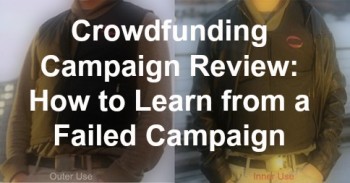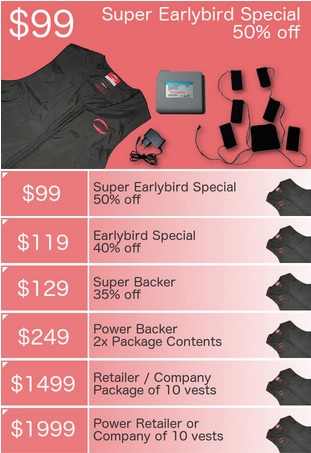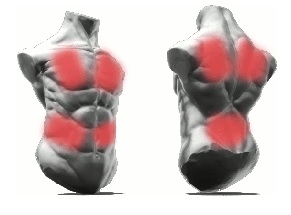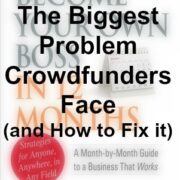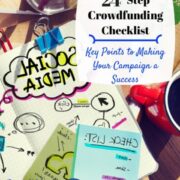Crowdfunding Campaign Review: Learning from a Failed Campaign
Here on the Crowd101 blog, we love to post crowdfunding campaign reviews about how they are using the new movement to fund their dreams. If you’re thinking about launching a crowdfunding campaign, you’ll never find better advice that from the people that are making it work. It’s a great opportunity to learn from their success and their mistakes.
Today’s crowdfunding campaign review comes from Sarah Mensah, co-founder of the Copertura Label and an Indiegogo campaign for the Heated Vest. The vest is an innovative jacket that can be worn as an outer garment like a traditional vest or under your regular clothes. You control the pads which supply up to 18 hours of warmth at the lowest setting and up to eight hours of warmth at the maximum temperature of 104 degrees fahrenheit. Besides in cold weather, it can also be used to control back pain by placing heat in the right spot.
Thank you for sharing your crowdfunding experience Sarah. First, Tell us a little about yourself.
Thank you. I was born and raised in Berlin, Germany where I studied to be a paralegal after high school. I am passionate about design, fashion and technology which is how I really got interested in wearables. I love working on designs and creating new things. I have been working on the Copertura Label for two years, perfecting our designs like the vest we are crowdfunding.
Wearable tech is hot right now but everyone is focusing on a watch product, I’m amazed more people are not coming out with clothes. The vest seems really interesting both from a practical point of view and from an innovation standpoint.
Did you try to raise any money before crowdfunding?
No, crowdfunding has been our first stop to raise money. We wanted to gauge public support before we go to any traditional sources.
One of the great benefits to crowdfunding is that it can be used as a survey tool to get customer feedback. This is why I always advise crowdfunding campaigns to make the lowest reward level one dollar and to urge people to become a part of the campaign’s community. Even if people do not contribute, you can still contact them to get their critique on the product.
Have you ever done a crowdfunding campaign before?
We tried another campaign last year but were not successful. With the feedback from that campaign, we were able to improve our product and we’re confident that we’ll reach our goal this time.
There is a lot made of the high failure rate in crowdfunding. It sucks to spend all that time and then ultimately not reach your goal. The thing is if you are a small business, then you really have not lost anything by attempting a crowdfunding campaign. The video and marketing material can be reused and unsuccessful campaigns are great for getting you to rethink your business strategy. Of course, that doesn’t mean you want to fail but it’s not the end of the world when it happens.
What did you do before starting the campaign to get ready? Can you take us through your process?
We sat down for days to develop our marketing material, flyers and the strategy we would use. We presented the product in-person to several groups and perfected our pitch. We spent a lot of time re-developing our website, taking pictures and making the campaign page visually attractive.
We also put a lot of time in on the video, first in meetings to develop the script and how we wanted it to look then with the actual filming and editing. The whole Copertura Label team really worked night and day on the project.
It sounds like Sarah and her team put in a ton of work on designing and launching the campaign but they might have missed one of the most important parts of crowdfunding, pre-launch. Crowdfunding campaigns are usually a max of two months on most platforms and that isn’t enough time to build support or a community online. To do these things, you really need to spend at least three months or more building support before you launch. I’ve posted a couple of articles on pre-launch crowdfunding activities including a step by step guide on creating a blog for your crowdfunding campaign.
What has surprised you most about running a crowdfunding campaign?
It has really surprised all of us how much work and time goes into running a crowdfunding campaign. We were able to draw from our experience in the previous campaign but still a lot of things had to be created from scratch.
We work on the campaign every day, well into the night. It’s tough to keep track of the hours because it is your baby and you’re really always thinking about it. Crowdfunding definitely isn’t like a normal 9-to-5 job where you get off work and relax. We go to a lot of meetings and social gatherings to present our product and get feedback.
Time is the biggest surprise for most crowdfunders. Running a successful campaign can easily turn into a part-time job months before you launch and demand your time well after your campaign has concluded. It is definitely worth it for those that plan their campaign and are successful meeting their funding goal. In what other way can you raise thousands of dollars that don’t have to be paid back while doing marketing and outreach activities that you would have to do anyway for any small business?
Sarah brings up a huge opportunity for crowdfunding campaigns with a tangible product. Conferences are best but you can do this in any large social gathering. Take your product and let people try it out. Take a tablet or two with you so they can go right to your crowdfunding campaign and become supporters. I have talked to crowdfunding campaigns that made their entire funding goal in one day by going to tech gadget conferences and setting up a display table. There are a lot of really cool gadgets being crowdfunded but they struggle because they are difficult to demonstrate just through the video. For campaigns where this is true, like wearables, you may even consider planning your crowdfunding campaign around conference dates.
What is the biggest mistake you’ve made so far in crowdfunding?
We chose the wrong platform for our first campaign. The one we were using made it really difficult for people in Europe to support us. We’ve improved this by launching on Indiegogo this time.
This is a big problem in crowdfunding. Indiegogo gets about nine million visitors a month while Kickstarter draws about 13 million monthly visitors. Beyond the two giants, traffic can be much lower at other crowdfunding sites. As a result, most campaigns jump on one of these two without really looking at the alternatives. While Kickstarter may boast a massive amount of visitors, they might not care in the least for your product and the site may not offer the features you need. A smaller site like Causevox, which focuses on non-profit crowdfunding, may offer more targeted traffic and features for your campaign.
What do you think is the thing you’ve done really well so far?
We listened to people, backers from the previous campaign. We surveyed criticism about the product and got feedback so we could improve the product. You will hear a lot of people say, “Wow, nice product. Good luck!” but the most valuable advice will come from people that care enough to offer a critique.
How are you reaching people on an emotional level?
It is difficult because it is a very practical product. We struggled with the emotional aspect because we would all sit there and say, “Emotional needs? Why? It is a great product that does exactly what it promises. Why do we have to reach people emotionally.” We finally realized that it was serving an emotional need, that of comfort and warmth, and tried to tap in to those feelings.
What 3 resources or tools should every campaign have?
Every campaign should definitely have a video, an informative and professional website and a good presentation on the crowdfunding platform. The campaign page needs images of the product and of people using it and should also include images of the entire team.
Sarah hit on three really ‘must-haves’ for every project. Campaigns with videos have better than a 50% chance of getting funded while those without videos see their odds drop to 30 percent. It doesn’t have to be a Hollywood production but you need a video and you need to be in it.
Campaigns need a website but I would also add that they need to use the website correctly. You should be using your website to tie everything together, from your campaign page to your social media profiles to all your other marketing activities. Make sure you have an email subscriber sign-up and that you are asking people to join your community. Another article posted today was a massive step-by-step guide to creating your crowdfunding campaign blog and we’ll follow it up tomorrow with how get people to visit your crowdfunding blog.
What’s next for you?
We are working hard to reach our target and bring our heat vest to the market. With the timeline we’ve set up, we’ll be able to deliver it before the next winter season so we are excited about seeing it in action on a large scale.
We’re having a great time talking to people about crowdfunding and about our project. It is definitely not easy but nothing is impossible. We tell everyone to spend months before the campaign in building a strong community and getting support.
As I finish up loading this crowdfunding campaign review into the blog, Sarah’s heat vest campaign has raised $1,456 from 20 supporters and still has 46 days left. They’re 15% toward their goal which means they’ve got a really good chance of reaching it. I want to thank Sarah for taking the time to talk with us and share her experience with crowdfunding. If you’ve got a campaign you’d like to share or just want to share your experience with crowdfunding, email me or use the comment section below.
